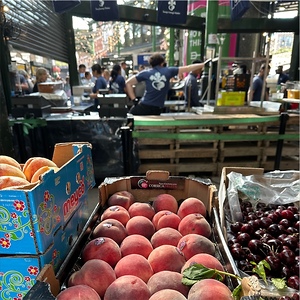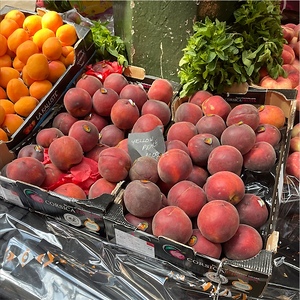


Corsica Peaches
Estimated Inventory, 1 Lb : 0
Description/Taste
Corsica peaches are generally small to medium-sized stone fruits, depending on the specific variety, and have a round, oval, to ovate shape. The fruit’s skin is thin, taut, and easily bruised, showcasing dark red, purple, to white hues covered in a layer of velvety fuzz. Underneath the surface, the flesh is soft, tender, and aqueous, encasing a central, light brown-red pit that can either be a freestone, easily separated from the flesh, or a clingstone, tightly adhered into the flesh. The flesh also bears white to yellow tones and may showcase splashes of red around the pit and just under the skin. Corsica peaches should feel heavy for their size and give slightly under pressure when ripe. The peaches emit an aromatic, floral, and honeyed scent and contain low acidity, contributing to a mild and refreshing, sweet, fruity, and subtly floral flavor.
Seasons/Availability
Corsica peaches are available in the late spring through early fall.
Current Facts
Corsica peaches, botanically classified as Prunus persica, is a general descriptor used for various peach varieties grown on the island of Corsica, belonging to the Rosaceae family. Corsica is a French island in the Mediterranean, lying south of continental France and west of Italy. The island is known for its warm, sunny climate and diverse terrain, and presently, Corsica grows over thirty different types of produce. Corsica has become known worldwide as a region that cultivates quality crops, and the island’s name is used on labels as a mark of excellence. Corsica peaches is a term to describe yellow and white peach varieties cultivated throughout the island. White peach cultivars are favored for their delicate flavoring and sub-acid nature, while yellow peach cultivars have higher acidity, creating a sweet and tangy taste. Corsica peaches are valued for their flavor, appearance, and aroma and are primarily consumed fresh in cooling summer preparations. Some varieties of Corsica peaches can also be utilized in cooked preparations, drink mixes, and fruit liquors.
Nutritional Value
Corsica peaches are a source of vitamin C to strengthen the immune system while reducing inflammation, vitamin A to maintain healthy organ functioning, and fiber to stimulate the digestive tract. The fruits also provide potassium to balance fluid levels within the body, vitamin E to protect the cells against free radical damage, magnesium to regulate optimal nerve functioning, and contain other nutrients, including vitamin K, copper, zinc, iron, phosphorus, manganese, and folate.
Applications
Corsica peaches have a refreshing and sweet flavor well suited for fresh and cooked preparations. The fruits are popularly consumed straight out of hand and are eaten as a light snack or dessert during the warm summer months. Corsica peaches are also favored for charcuterie boards, served with traditional meats unique to the island. The fruits can be used as a topping over breakfast dishes such as yogurt, oatmeal, and crepes, chopped into green salads, mixed into fruit bowls, or used as a garnish for baked goods. In addition to toppings, Corsica peaches are combined with yogurt, whipped cream, rum, citrus, and fresh herbs to make a chilled soup, blended into ice cream or sorbet, or soaked in a lemon and sugar syrup and then served in red wine. Beyond fresh preparations, Corsica peaches can be utilized in cooked dishes, poached in wine or syrup, grilled on skewers, baked into pies, crumbles, and cakes, roasted, or sauteed and served with main dishes. The fruits can also be paired with other stone fruits and simmered into jams, marmalades, and jellies. Corsica peaches pair well with herbs such as basil, mint, rosemary, and thyme, spices including cinnamon, cloves, nutmeg, and cardamom, stone fruits such as apricots, nectarines, and plums, turkey, poultry, and seafood. Whole, unwashed Corsica peaches can be left at room temperature to ripen for 2 to 3 days. Once ripe, the fruits should be stored in a ventilated bag in the refrigerator’s crisper drawer. Peaches can also be frozen in slices for extended use.
Ethnic/Cultural Info
Corsica is known as the “Ile de Beauté,” translating to mean the “Isle of Beauty.” The French Island is located in the Mediterranean and is known for its mountainous landscape, hilltop villages, forests, chaparral, and rocky coastal towns. Corsica is steeped in tradition, with communities dating back to 560 BCE, and throughout history, the island has become a home for artisans. Despite the island's rich heritage, many towns have been abandoned on the hillsides as families choose to move into more populated areas along the coast. To preserve these dwindling towns, the Regional Committee for Expansion and Agricultural Promotion of Corsica, also known as CREPAC, decided to establish the Route des Sens Authentiques, translating to the Route of the Authentic Senses. Eight different routes were created across the island for visitors to learn about local art, agriculture, gastronomy, and wine. It is estimated that more than 4,000 farmers participate in this agrotourism program, and each farm will have a sign indicating they are a part of the route, welcoming visitors to stop in. Corsica peaches are featured on the Route des Sens Authentiques of the Balagne. This route travels from Urtaca to Avapessa and spans 109 kilometers. Throughout this route, visitors can choose to visit sixty different locations, including peach, olive, and almond orchards. The region of Balagne is known for its rich orchards, essential oil production, violin making, and ceramics.
Geography/History
Corsica peaches are descendants of peaches native to China, specifically to regions along the Yangzi River. The first record of peach cultivation was documented in Chinese manuscripts as early as the 10th century BCE. Over time, peaches were extensively bred throughout China for improved flavor, appearance, and texture. Peaches were later transported along the Silk Road into the Middle East and were eventually introduced into Europe. It is unknown who introduced peaches into France and neighboring Mediterranean countries, but historians believe the fruits most likely arrived sometime before the common era. Today Corsica peaches are cultivated on Corsica, the French island in the Mediterranean, which has been one of the 18 regions of France since 1768, but the island also has Italian roots. Corsica peaches are a seasonal crop grown on the island's hillsides and are sold domestically and exported to Europe as a specialty fruit.









